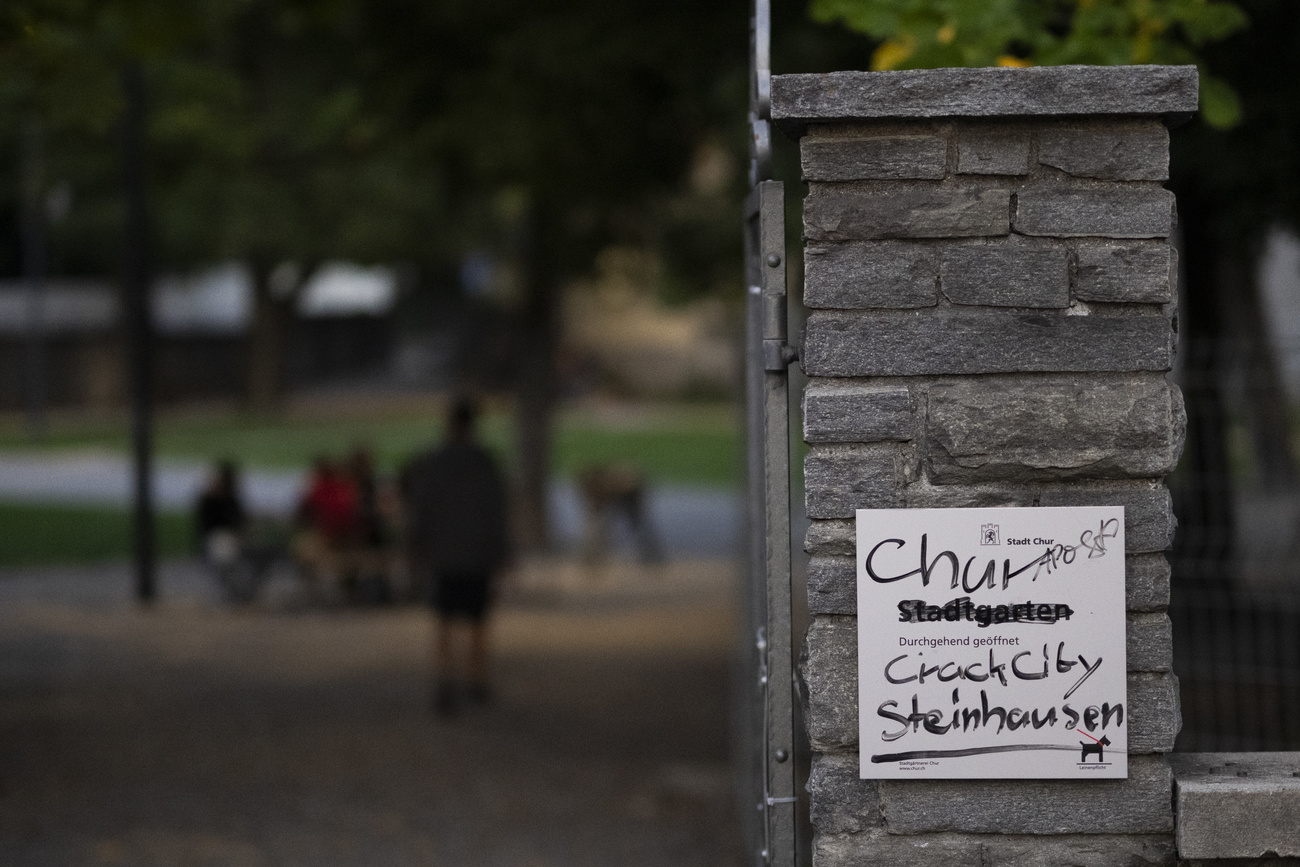Crack cocaine crisis escalates in Switzerland

Since 2020, crack consumption has tripled in French-speaking Switzerland and is spreading rapidly across the country, including Lugano. A user shares her experience with Swiss public television, RSI.
She has been consuming this destructive drug for years. “It’s hard for me to accept that I’m always searching for crystal – I only think about crack,” she confesses.
Fabienne, whose name has been changed to protect her privacy, is 35, has been unemployed for months and spends her time seeking money to buy crack. Once the effect, which lasts just under half an hour, wears off, she immediately craves another dose, entering a vicious cycle from which she struggles to break free.
We meet Fabienne in Lausanne’s new consumption room, which opened in May just steps away from Place de la Riponne, the city’s main open drug scene. According to a study by the University of Lausanne (UNIL), Lausanne has now become the Swiss capital of crack consumption.
Swiss public television, RSI, was granted access to Lausanne’s new consumption room. Here, drug consumption is permitted under “safe” conditions, with clean materials and supervision by nurses and social workers.
“For us, having this space is very positive. It’s not nice to consume outdoors where there are children. In fact, I think we need more rooms like this,” says another crack user, a 44-year-old former heroin addict and mother of three children. This user no longer sees her three children.
Two consumption rooms in Lausanne
The consumption room is run by the ABS Foundation and is the second of its kind in Lausanne. It is part of a three-year pilot project costing CHF1.2 million ($1.4 million) annually. This facility is only 500 metres away from the first centre, which opened more than a decade ago in the Vallon area.
The new facility is specifically designed with separate rooms for different forms of drug use: injection, inhalation, and snorting. It is built to accommodate crack smokers, a growing user group. On average, the centre sees between 140 and 260 visitors, and 90% of those who come to smoke inhale crack.
“The other centre is not far away,” says Matthieu Rouèche, director of the ABS Foundation. “But despite being only 500 metres away, for some users the distance is a barrier. Especially for those in a hurry to consume crack, this space was designed to be as close as possible to where they buy the substance.”
Crack use reaches canton Ticino
Since 2020, crack consumption has surged throughout Switzerland, with the drug becoming increasingly visible in places like Lugano, a city in canton Ticino.
We visited a park that is frequented by crack users and spoke to several of them. “How much do you smoke a week?” we ask one man, who shows us his pipe. “I smoke on Mondays, Wednesdays and Fridays, and I spend CHF50 ($58) each time.”
A dose costs around CHF20. According to local sources, over 80% of drug deals at the park we visited now involve crack. “Snorting cocaine gives you a certain kind of effect,” says another user. “But when you smoke it, you feel instant ecstasy, calm and happiness. But the effect lasts only five or ten minutes, and then you want more. You become violent, and afterwards, you’ll steal or prostitute yourself to buy more crack.”
Crack is cheap, easily accessible, and highly addictive. It is also associated with extreme aggression when supplies run low.
The Ingrado day care centre in Viganello serves around 40 substance-dependent users daily. About 140 people are in outpatient treatment. Nearly 1,000 crack pipes were distributed in the first eight months of this year – three times more than two years ago.
“I’ve been working here for ten years, and I’ve seen a significant change in the type of users,” says José Di Stefano, head of the centre. “Before, people were sedated by opiates like heroin. Now they’re hyperactive and agitated, under the influence of crack. Unfortunately, we’re seeing more aggression and violence, especially in public spaces where people are using drugs.”
‘I used to sell 100 doses a day’
At the Villa Argentina therapeutic centre in Collina d’Oro in canton Ticino, we meet Filippo (not his real name). He wound up in prison in 2023 due to his crack usage. He is now serving his sentence in this therapeutic centre with hopes of reintegration into society.
“I used to stay at home, cook up crack cocaine with water and bicarbonate, package it, and then go to the park to sell it. With my level of consumption, I needed more money, so I started selling it. It was easy to find customers – I was earning CHF1,500 to CHF2,000 a day, selling about 100 doses daily,” he says.
Filippo spent all his life earnings on drugs. Today, he is trying to escape the grip of addiction and start a new life.
Forty years of consumption rooms in Switzerland
Like Filippo, many users in Switzerland are trying to break free. This is well known in the various “low-threshold” drop-in centres that practise harm reduction, one of the four pillars of Switzerland’s federal drug policy. These centres aim to limit the risks of drug use by providing counselling and, in some cases, offering safe consumption spaces. Such harm-reduction initiatives have been in place in Switzerland for 40 years.
In 1986, the first consumption room opened in canton Bern, followed by canton Zurich in the 1990s, where projects involving therapeutic heroin use also began. Today, there are 15 such rooms across eight cantons, with more to come.
After heroin, crack cocaine is now the Swiss authority’s primary concern. In spring, the Federal Office of Public Health (FOPH) convened cities, cantons and experts for a second roundtable in one year, raising the alarm about the dangers of crack cocaine.
‘Consumption rooms are necessary’
FOPH Director Anne Lèvy told RSI that the meeting highlighted how cities with consumption rooms can respond much more quickly to the rise of dangerous substances like crack. “These municipalities can react earlier than those without such facilities or those that have yet to build spaces suitable for crack consumption. This new group of addicts is causing significant problems, particularly in public spaces,” says Lèvy.
The FOPH recommends that cities establish low-threshold centres open 24 hours a day, equipped with spaces for safe drug consumption. One example is the town of Chur in canton Graubünden, which has been in a state of emergency due to the explosion of drug usage for two years.
Chur has a population of 36,000 and has one of the largest open drug scenes in Switzerland. Crime has risen by 23% in one year due to increased drug use. In June, the population approved CHF3.88 million to build a consumption hall.
Fribourg aims to curve the spread of crack
In August, a new consumption hall opened in Fribourg, run by the Le Tremplin Foundation. The Fribourg cantonal government strongly supported the creation of this space after years of discussion, considering it a priority in their 2022-2025 plan to manage the spread of substance abuse.
“In our canton, there is no crack emergency at the moment,” says Nicolas Dietrich, Fribourg’s cantonal addiction delegate. “But with this space, we want to get ahead of the issue. This facility provides multiple benefits for the population and for users’ health. Having access to sterile tools and supervision from experts reduces the risk of communicable diseases and improves users’ quality of life,” he says.
The room is open from 11am to 3pm Monday to Friday and had registered 62 users in its first few days after opening. An estimated 1,500 people in Fribourg are addicted to illegal substances, and the annual cost of managing addiction across the canton is CHF322 million.
No consumption rooms yet in canton Ticino
In canton Ticino, addiction centres treated around 1,000 people in 2023, up from 700 a decade ago. Among younger users, the figure has more than tripled from 18 users under 20 years old in 2013 to 66 users under 20 in 2023. Despite this, there are still no consumption rooms in the canton, although Lugano has been discussing the possibility for over a year.
At a press conference presenting the cantonal drug intervention plan on September 10 of this year, experts explained that establishing a consumption room depends on critical mass and cost. “It needs to be assessed whether it’s necessary,” they said.
According to research by Infodrog, harm-reduction services like drop-in centres save CHF340 million annually in follow-up costs. The costs of such services across Switzerland total approximately CHF60 million, while direct drug addiction costs in Ticino were around CHF5.5 million in 2023.
“In Chur, a small town, it took just one year to secure funding and build a consumption room,” says Gerri Beretta Piccoli, a former street social worker. “It’s sad that in a city like Lugano, which aspires to be international, there’s still no such facility. The municipal authorities have been discussing it, but nothing has materialised. You need the courage to place it near the drug consumption areas. It’s no use putting it on top of Monte Brè,” Piccoli says.
Translated from Italian using DeepL/amva/ts

In compliance with the JTI standards
More: SWI swissinfo.ch certified by the Journalism Trust Initiative








You can find an overview of ongoing debates with our journalists here . Please join us!
If you want to start a conversation about a topic raised in this article or want to report factual errors, email us at english@swissinfo.ch.